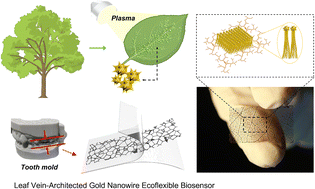Flexible biosensors and bioelectronics for real-time healthcare monitoring require high sensitivity and durability, yet their high-cost materials and complex fabrication often hinder clinical translation. Emerging bio-templated electronics leverage evolutionarily optimized natural architectures to overcome these synthetic limitations. Here, we harness the bioinspired, hierarchical structure of natural leaf veins to create an ecoflexible, high-performance sensor, which feature a unique hierarchical, multibranching structure that enhances both mechanical performance and sensing efficiency. By integrating gold nanowires with the leaf vein framework through a gradient-decellularization process, we developed a sensor that demonstrates exceptional stretchability, sensitivity, and stability. The resulting piezoresistive sensor achieves a remarkable gauge factor (GF = 2.17 × 102), a wide sensing range (∼60 kPa), and rapid response time (∼210 ms for response and ∼190 ms for recovery). Furthermore, it maintains excellent long-term stability, consistently performing over 1000 cycles at 40% strain. Such bioinspired leaf vein-architected gold nanowire ecoflexible biosensors offer a cost-effective, scalable solution for real-time occlusal force monitoring and broader medical applications, paving the way for multifunctional, flexible biosensors in wearable electronics and personalized healthcare.
